Білонога миша
Білонога миша (Peromyscus leucopus) — гризун родом з Північної Америки, який населяє провінцію Онтаріо, Квебек, Лабрадор та приморські провінції (за винятком острова Ньюфаундленд) на південному заході США і у Мексиці.[1] У приморських місцях вона мешкає в основному в південній частині Нової Шотландії.[2] Також вона відома як woodmouse (від англ. "деревна миша"), особливо в Техасі.
? Білонога миша | ||||||||||||||||||||||||
|---|---|---|---|---|---|---|---|---|---|---|---|---|---|---|---|---|---|---|---|---|---|---|---|---|
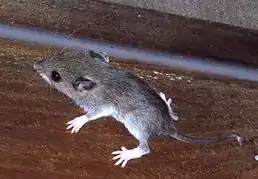 | ||||||||||||||||||||||||
| Біологічна класифікація | ||||||||||||||||||||||||
| ||||||||||||||||||||||||
| Peromyscus leucopus (Rafinesque, 1818) | ||||||||||||||||||||||||
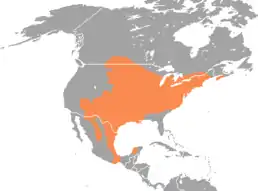 | ||||||||||||||||||||||||
Посилання | ||||||||||||||||||||||||
| ||||||||||||||||||||||||
Характеристики
Дорослі особини 90-100 мм у довжину, не враховуючи хвіст, який може додати ще 63-97 мм. Молодняк важить 20-30 г. В той час як їх максимальна тривалість життя становить 96 місяців, середня тривалість життя виду становить 45,5 місяців для самок і 47,5 для самців. У північних краях їх середня тривалість життя становить близько 12-24 місяців.[3]
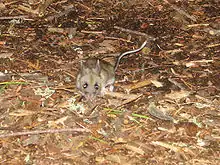
Поведінка і раціон
Білоногі миші всеїдні, харчуються насінням і комахами. Вони боязкі і взагалі уникають людей, але інколи поселяються на першому поверсі стін будинків і квартир, де вони будують свої нори і зберігають там знайдену їжу.[4]
Споріднені види
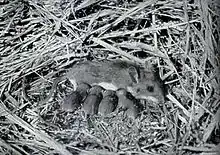
Білонога миша споріднена з схожим видом Peromyscus maniculatus. Як і оленячий хом'ячок, вона може нести небезпечні хантавіруси, які викликають важкі захворювання у людини.[5]
Відношення до хвороби Лайма
Також було виявлено, що представники цього виду можуть бути природними резервуарами для спірохети хвороби Лайма, Borrelia burgdorferi.[6]
Див. також
- Вірус Мононгіела
Посилання
- L.R. Lindsay, I.K. Barker, G.A. Surgeoner, S.A. McEwan et G. Douglas Campbell (1997). Duration of Borrelia burgdorferi infectivity in white-footed mice for the tick vectors Ixodes scapularis under laboratory and field conditions in Ontario (pdf). J Wildl Dis 33: 766–775. Процитовано 12 грудня 2016.(англ.)
- Atlantic Interior Архівовано 7 серпня 2011 у Wayback Machine., The Natural History of Nova Scotia(англ.)
- Mammalian models for research on aging (1981) ISBN 978-0-309-03094-6(англ.)
- WHITE-FOOTED AND DEER MICE. The Internet Center for Wildlife Damage Management. Архів оригіналу за 1 червня 2016. Процитовано 9 червня 2016.(англ.)
- RR5109-Front Cover-Hantavirus.p65(англ.)
- Reservoir competence of white-footed mice for Lyme disease spirochetes. Am. J. Trop. Med. Hyg. 36 (1): 92–6. Січень 1987. PMID 3812887. Вказано більш, ніж один
|pmid=та|PMID=(довідка)(англ.)
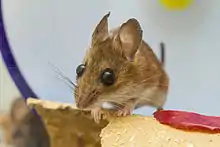
Література
- Anderson JF, Johnson RC, Magnarelli LA (1987) Seasonal prevalence of Borrelia burgdorferi in natural populations of white-footed mice, Peromyscus leucopus. J Clin Microbiol ; 25:1564–1566
- Anita Rogic, Nathalie Tessier, Pierre Legendre, François-Joseph Lapointe, Virginie Millien (2013) Genetic structure of the white-footed mouse in the context of the emergence of Lyme disease in southern Québec. Ecology and Evolution 3:7, 2075-2088, mis en ligne 1er juillet 2013 (résumé)
- Barthold, SW, Persing, DH, Armstrong, AL, Peeples, RA. (1991) Kinetics of Borrelia burgdorferi dissemination and evolution of disease after intradermal inoculation of mice. Am J Pathol ; 139:263–273
- Bunikis J, Tsao J, Luke CJ, Luna MG & al. (2004) Borrelia burgdorferi infection in a natural population of Peromyscus leucopus mice: a longitudinal study in an area where Lyme borreliosis is highly endemic. J Infect Dis ; 189:1515–1523
- Brunner JL, LoGiudice K & Ostfeld RS (2008) Estimating reservoir competence of Borrelia burgdorferi hosts: prevalence and infectivity, sensitivity, and specificity. J Med Entomol ; 45:139–147
- Burgess EC, French JrJB & Gendron-Fitzpatrick A. (1990) Systemic disease in Peromyscus leucopus associated with Borrelia burgdorferi infection. Am J Trop Med Hyg ; 42:254–259
- Goodwin BJ, Ostfeld RS & Schauber EM (2001) Spatiotemporal variation in a Lyme disease host and vector: black-legged ticks on white-footed mice. Vector Borne and Zoonotic Diseases, 1(2), 129-138.
- Hofmeister EK, Ellis BA, Glass GE & Childs JE (1999) Longitudinal study of infection with Borrelia burgdorferi in a population of Peromyscus leucopus at a Lyme disease-enzootic site in Maryland. Am J Trop Med Hyg ; 60:598–609
- Horka H, Cerna-kyckovaa K, Kallova A & Kopecky J (2009) Tick saliva affects both proliferation and distribution of Borrelia burgdoferi spirochetes in mouse organs an increases transmission of spirochetes by ticks. Int J Med Microbiol ; 299:373–380
- Martin LB, Weil ZM, Kuhlman JR & Nelson RJ (2006) Trade-offs within the immune systems of female white-footed mice, Peromyscus leucopus. Funct Ecol ; 20:630–636.
- Martin LB, Weil ZM & Nelson RJ (2007) Immune defense and reproductive pace of life in Peromyscus mice. Ecology ; 88:2516–2528
- Ostfeld RS, Miller MC & Hazler KR (1996) Causes and consequences of tick (Ixodes scapularis) burdens on white-footed mice (Peromyscus leucopus). J Mammal ; 77:266–273.
- Ostfeld RS, Schauber EM, Canham CD, Keesing F & al. (2001) Effects of acorn production and mouse abundance on abundance and Borrelia burgdorferi infection prevalence of nymphal Ixodes scapularis ticks. Vector Borne Zoonot Dis ; 1:55–63
- Pederson AB, Grieves TJ (2008) The interaction of parasites and resource cause crashes in wild mouse population. J Anim Ecol ; 77:370–377
- Schwan, TG, Burgdorfer, W, Schrumpf, ME, Karstens, RH. (1988) The urinary bladder, a consistent source of Borrelia burgdorferi in experimentally infected white-footed mice ( Peromyscus leucopus). J Clin Microbiol ; 26:893–895 (PDF, 4 pp).
- Schwan TG, Kime KK, Schrumpf ME, Coe JE et al. (1989) Antibody response in white-footed mice (Peromyscus leucopus ) experimental infected with the Lyme disease spirochete (Borrelia burgdorferi). Infect Immunol ; 57:3445–3451
- Schwanz LE, Voordouw MJ, Brisson D& Ostfeld RS (2011) Borrelia burgdorferi has minimal impact on the Lyme disease reservoir host Peromyscus leucopus ; Vector-borne and zoonotic diseases, 11(2), 117-124
Зовнішні посилання
- Білонога миша, Державний Університет Нью-Йорка, Коледж Екології та Лісового господарства(англ.)
- Білонога миша, CanadianFauna.com(англ.)
- Білонога миша, сайт Canadian Biodiversity(англ.)
 "Deer-mouse", Encyclopedia Americana(англ.)
"Deer-mouse", Encyclopedia Americana(англ.)
